American Optical Company
Scovill Mfg. Co., Proprietors
Flammang's Patent Revolving Back Camera Front Focus Variation 0.9
Dry
Plate Making for Amateurs, Scovill
Mfg. Co., 1886, ads p. 15. Can't tell whether this is Variation
0.9 or 1.0.
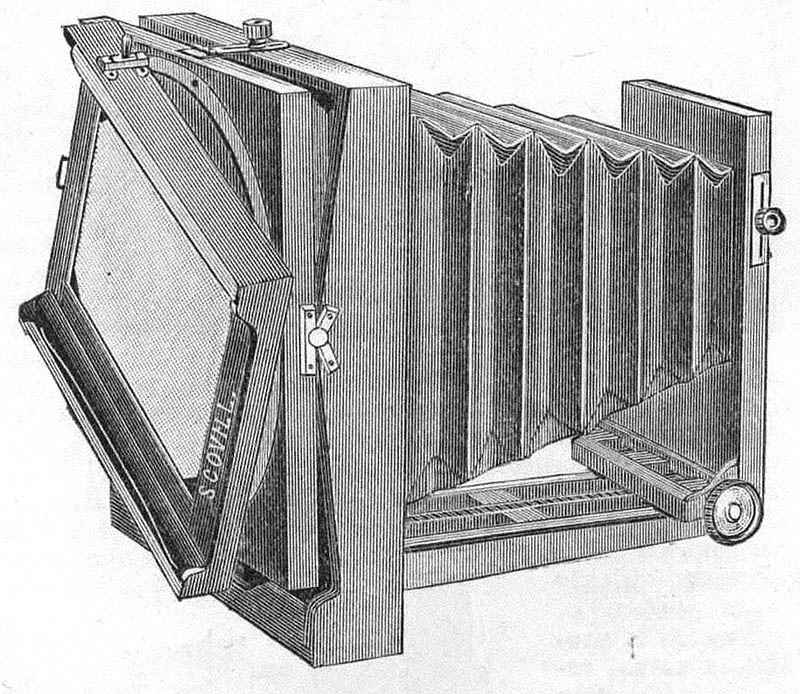
6½x8½
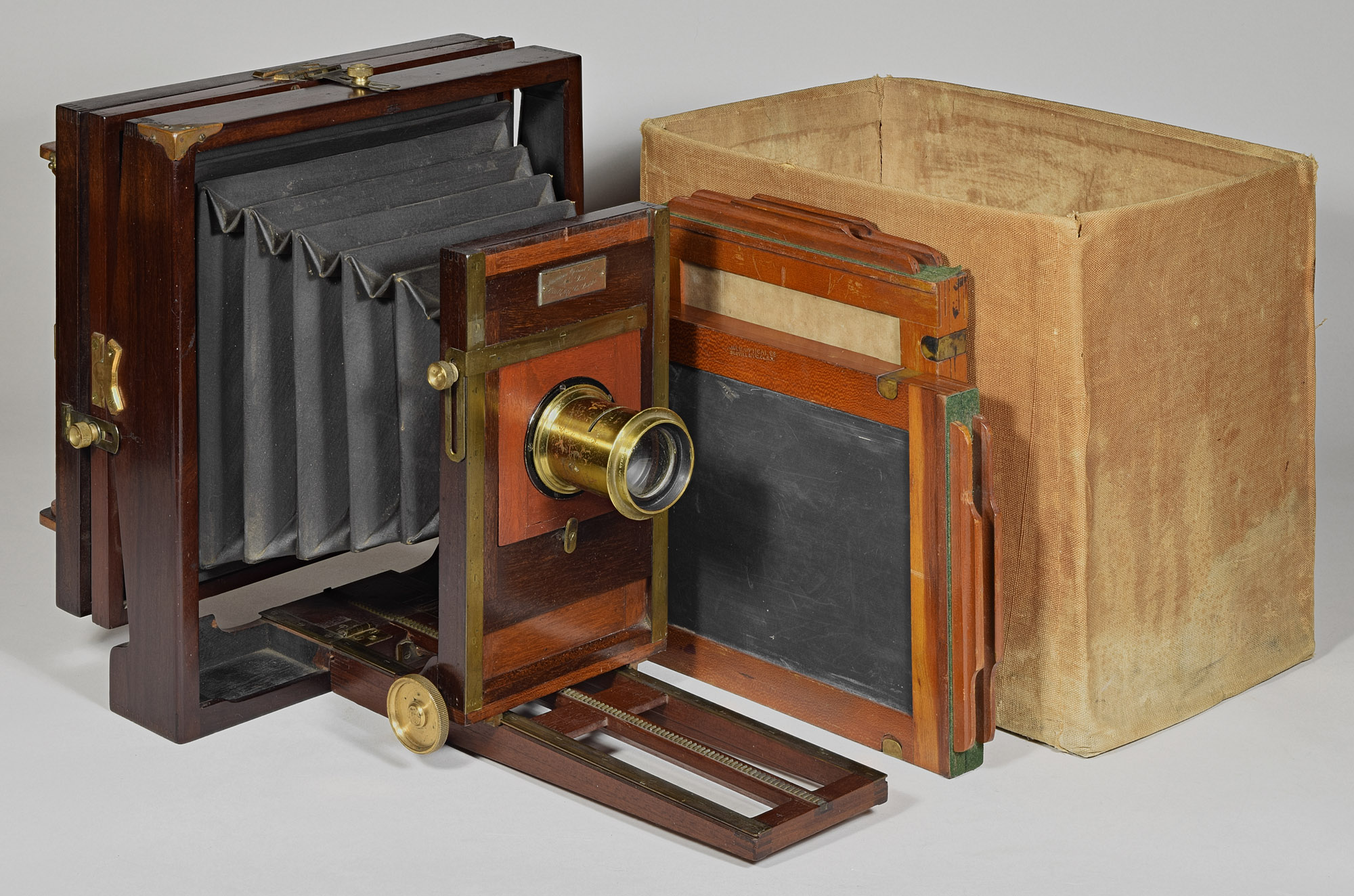
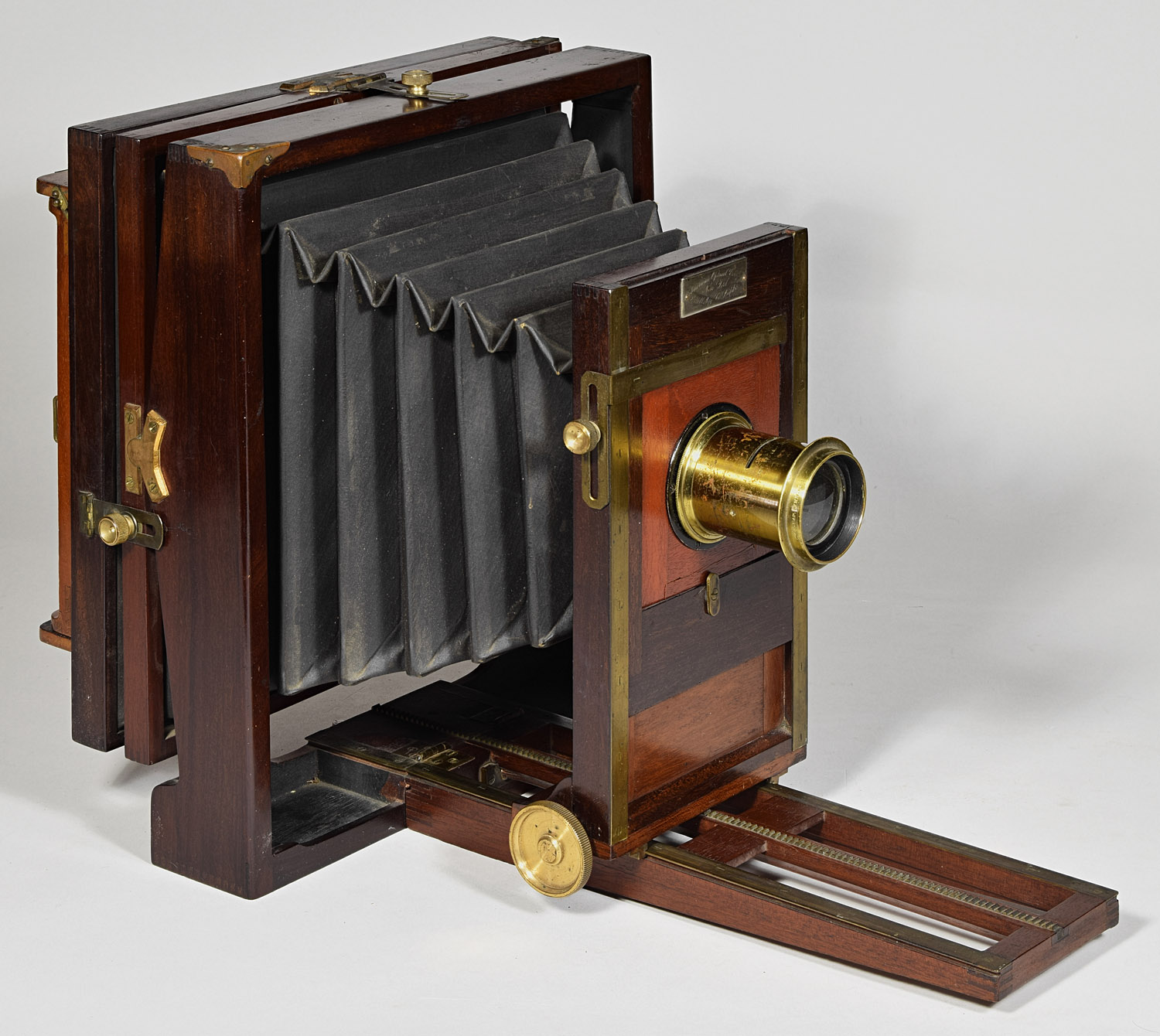

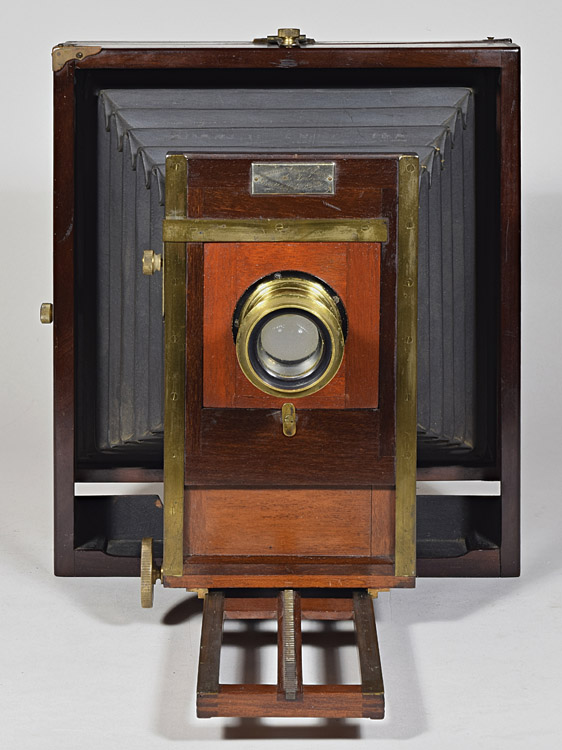
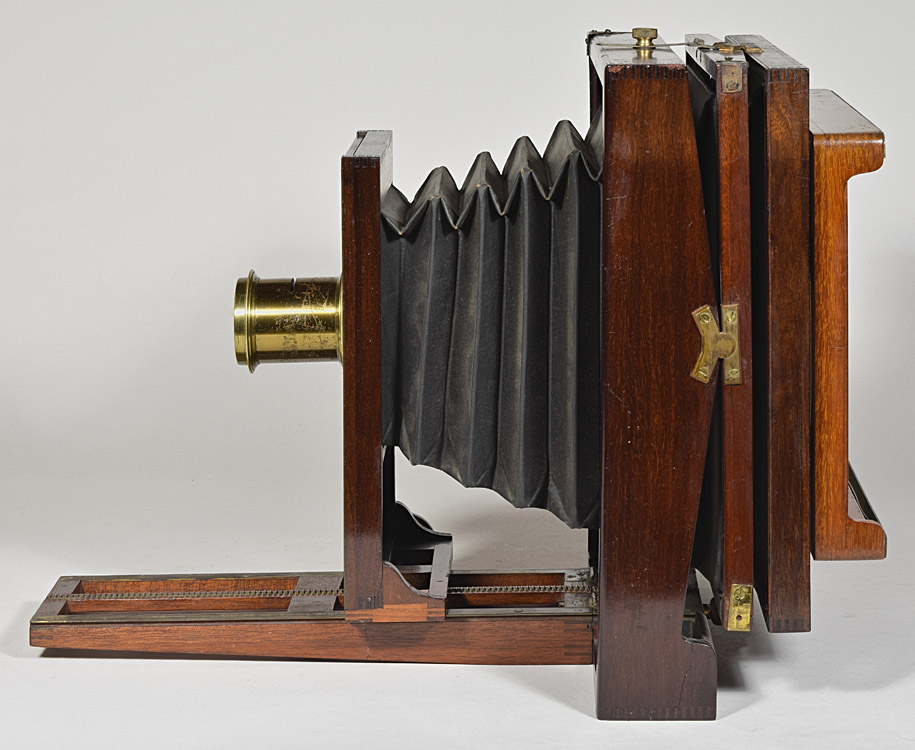
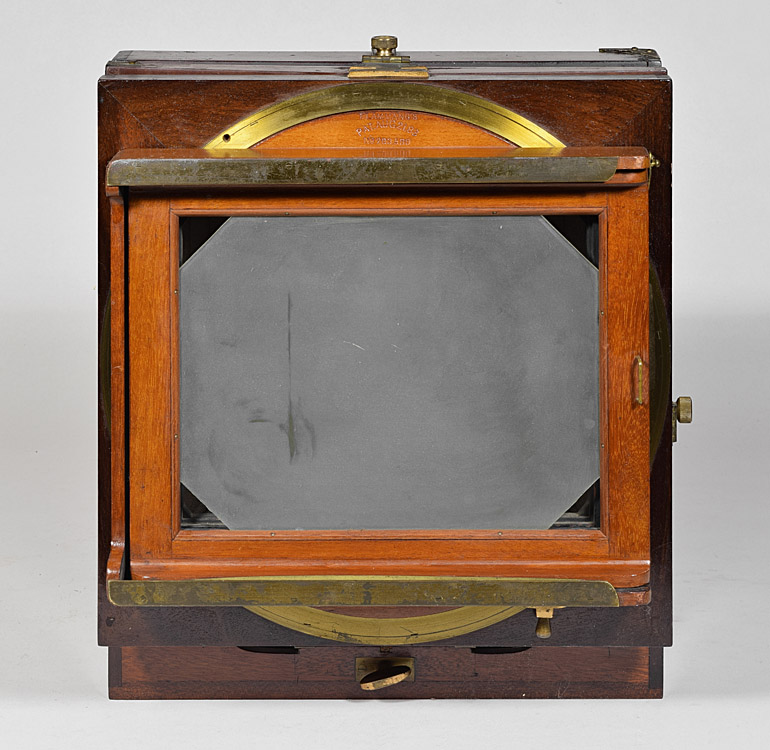
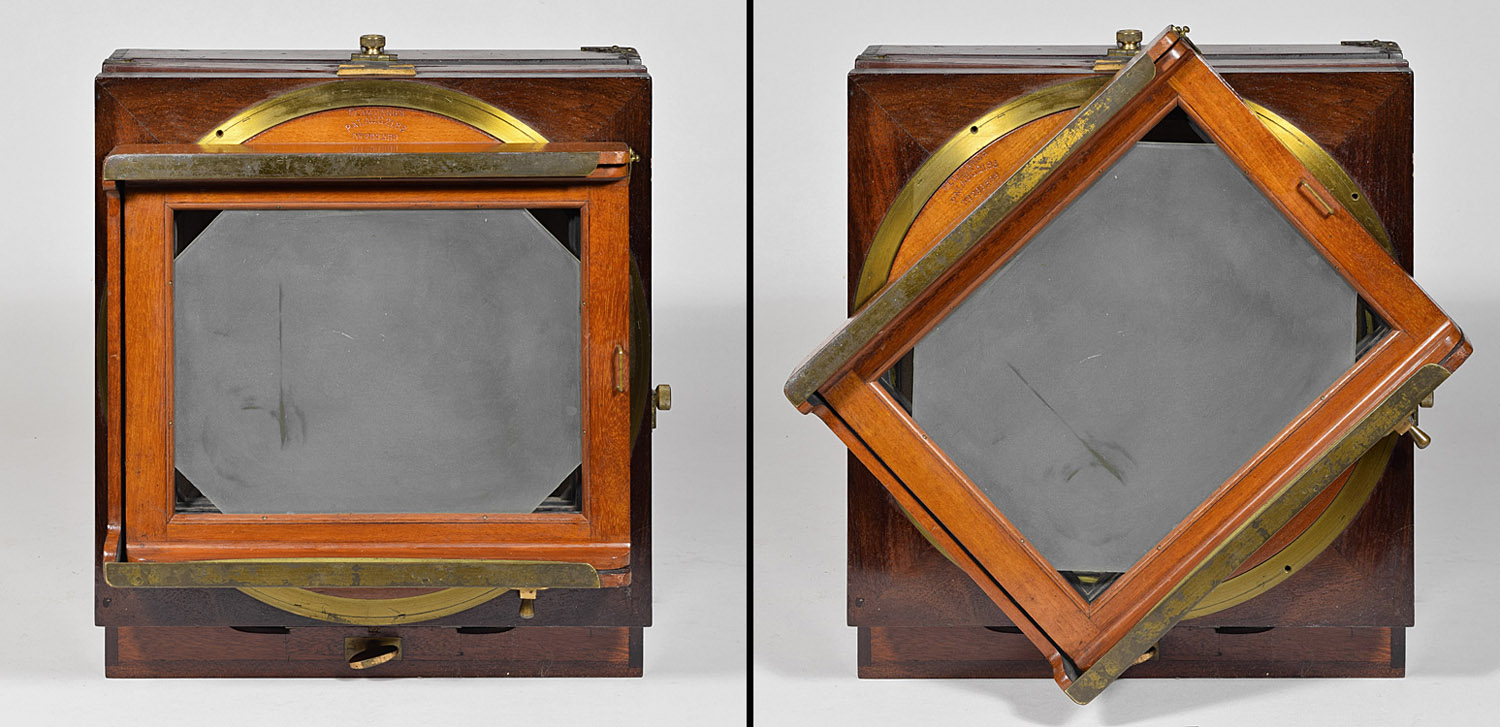
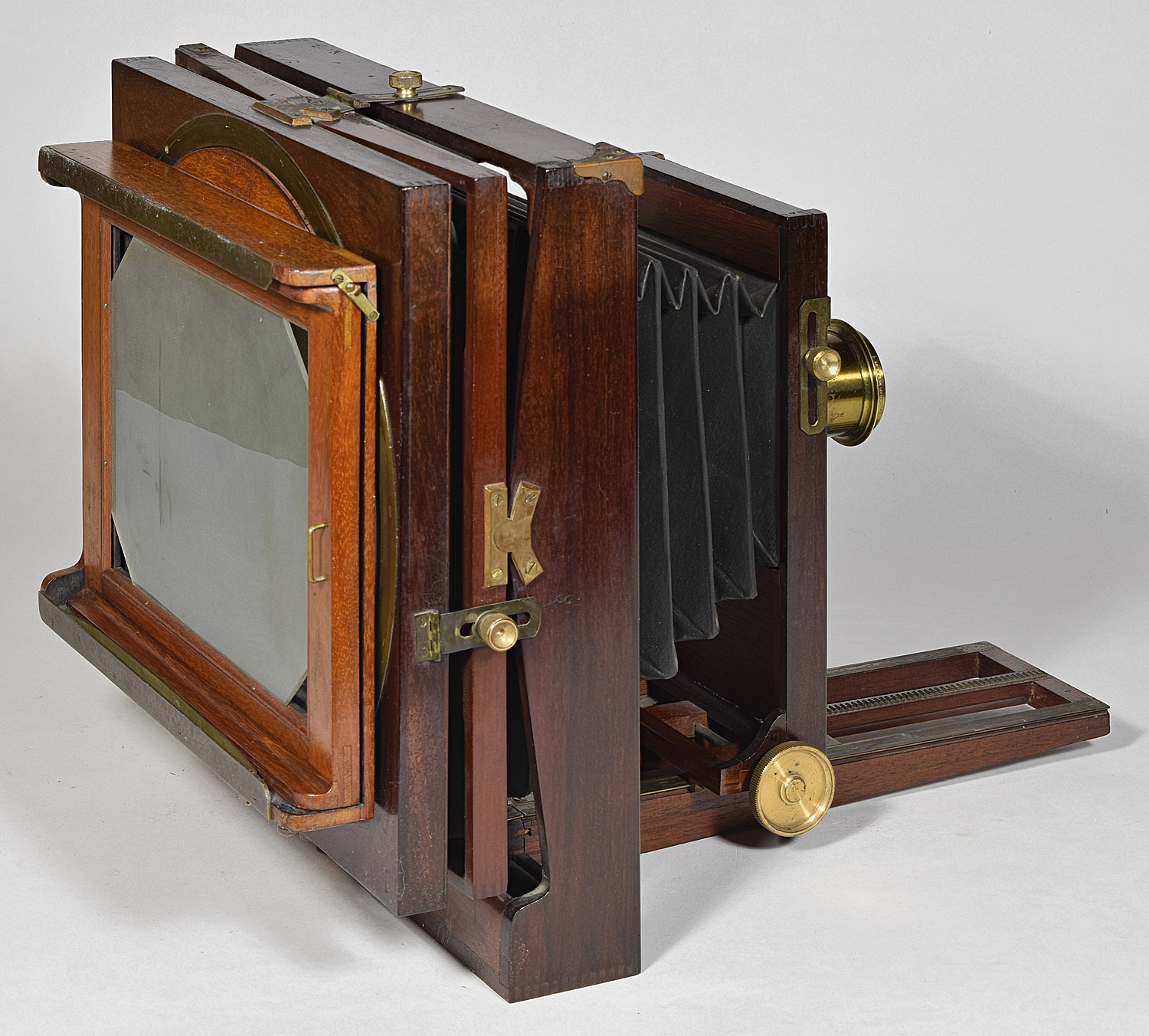
Bottom
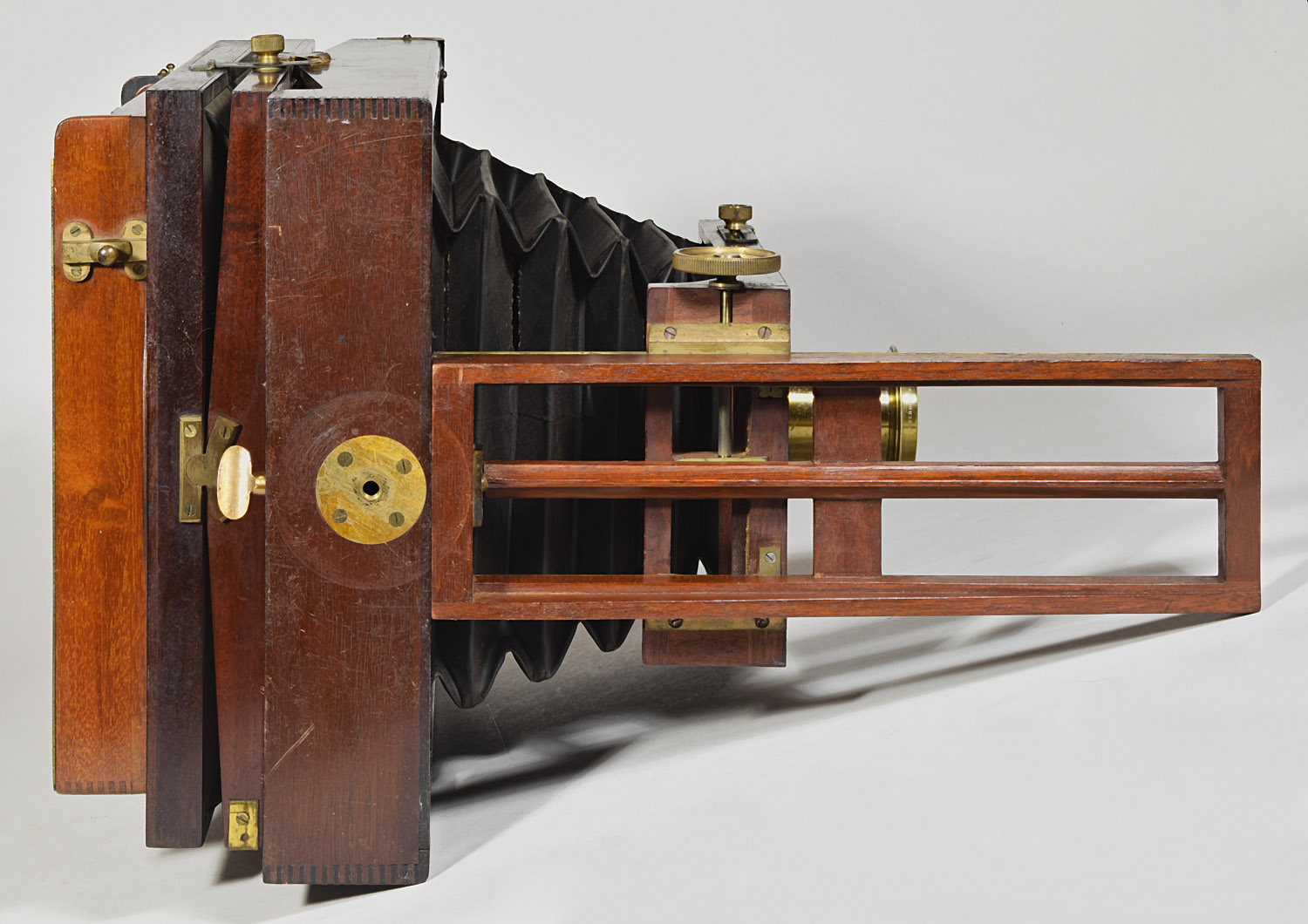
Top
On the far left, in lighter colored wood, is the part that holds the
ground glass frame or plate holder. On later variations, there
would be a brass device visible that prevents the ground glass frame or
plate holder from falling out - it is not present in this variation.
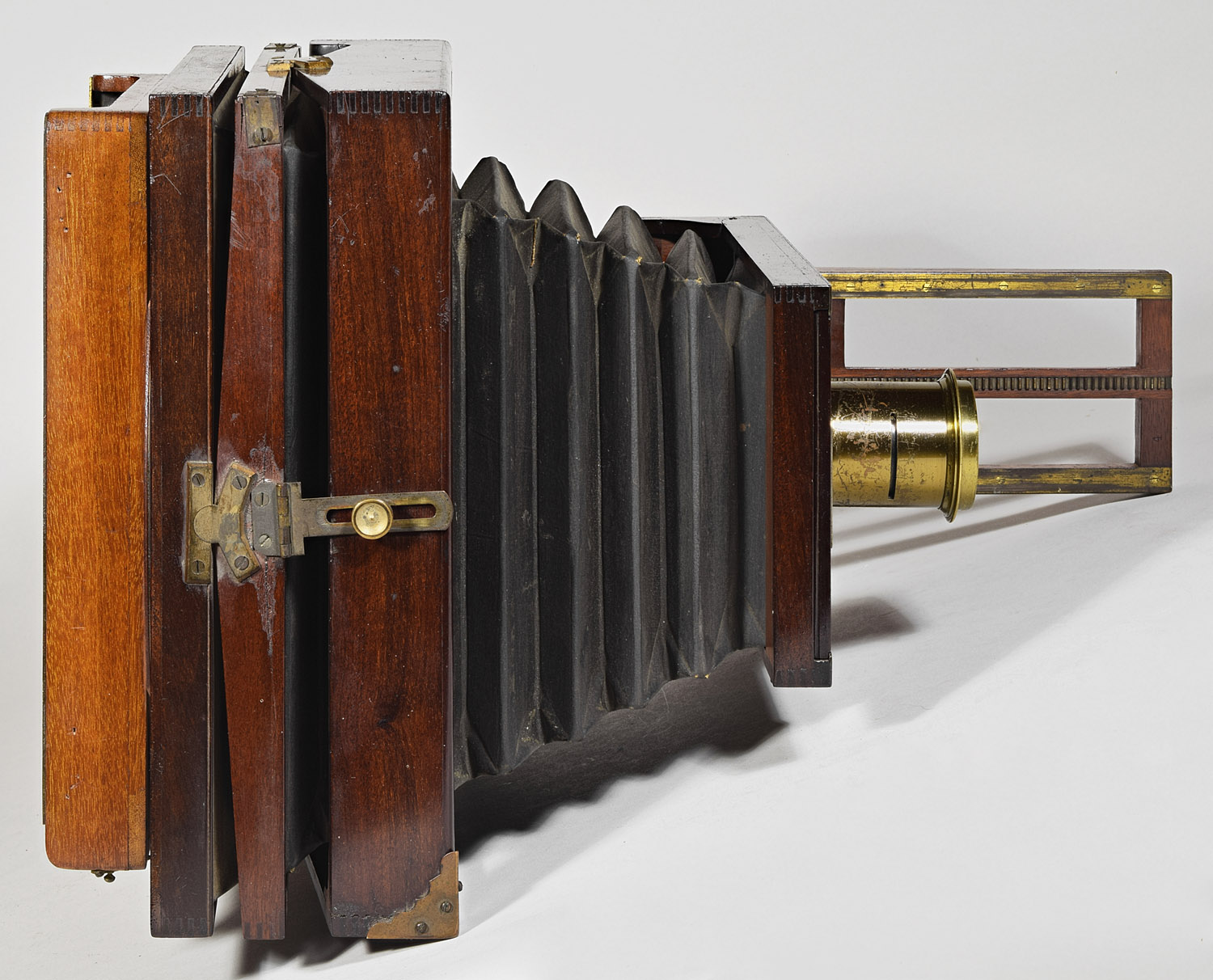
Brass label on the upper front standard of
the camera:
"American Optical Comp'y / New York / Scovill Mfg. Co., Prop't'rs".
Note the alignment of the screw slots vertically (on the edge guards of
the standardd) and horizontally (on the lens board retaining strip).
They were placed that way be trial and error and a pile of screws, then
a draw file technique was used to make the screw heads at exactly the
same level as the brass strip. The screws have never been
unscrewed throughout the life of the camera.
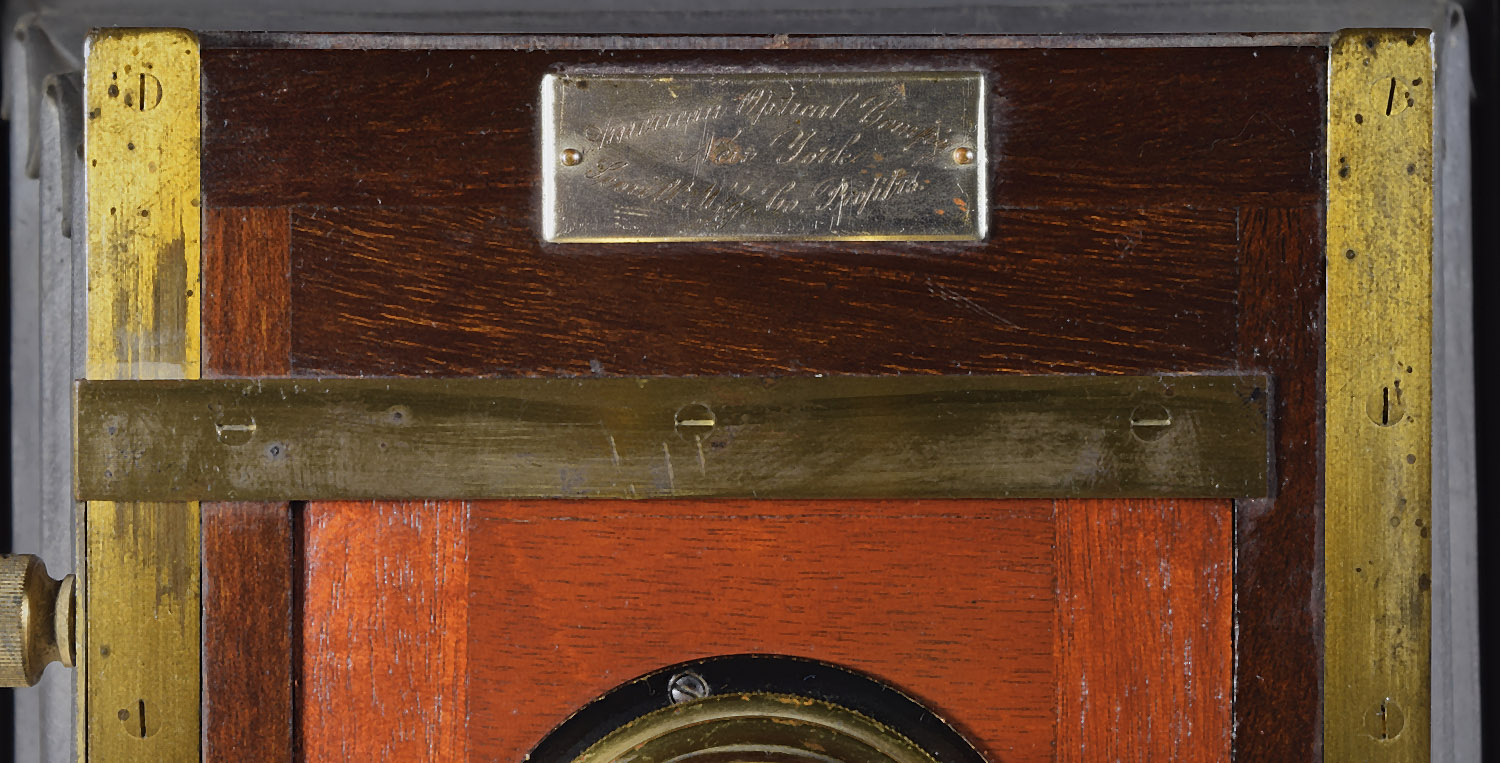
Patent stamp on back of camera: "Flammang's / Pat.
Aug. 21, 88 / No. 283,589". This patent refers
to the revolving back mechanism.
Note that, in
this photo, the screw head slots are aligned to be parallel to the
circumference of the brass circle.
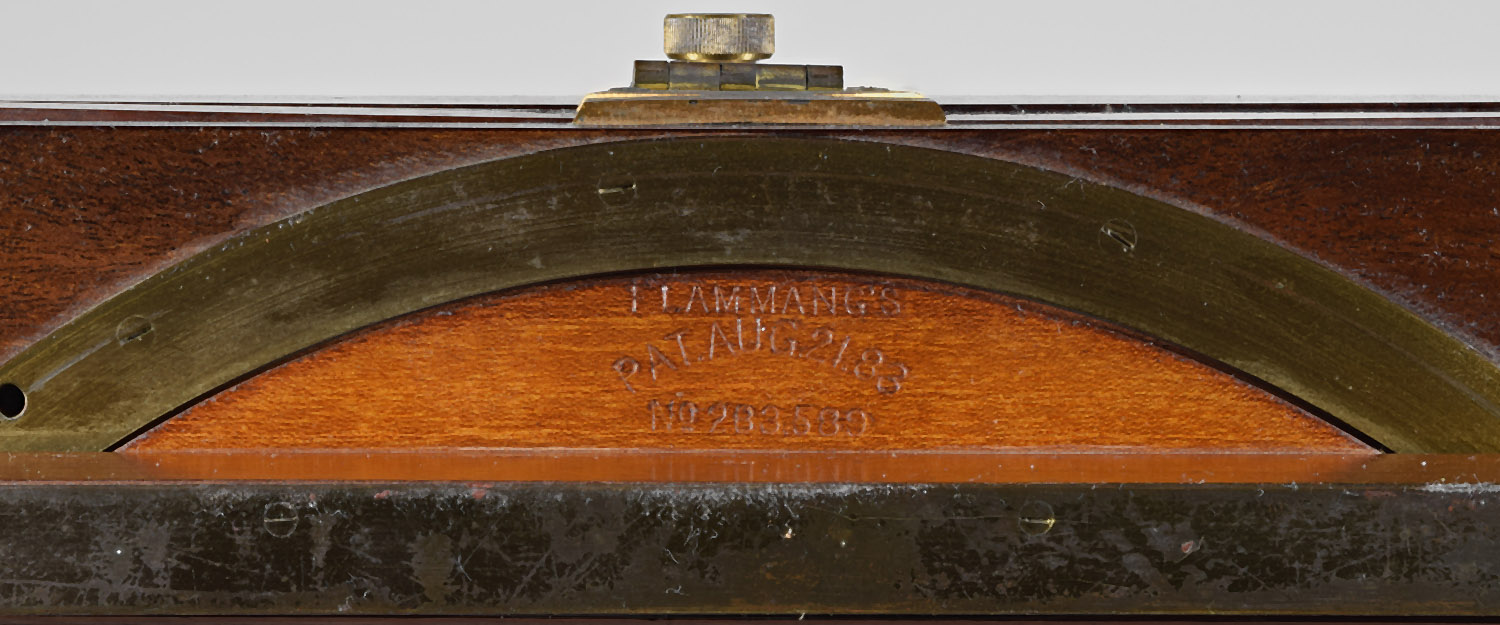
The main reason that this variation is 0.9
and earlier than 1.0 is the mechanism below for making the folding
platform rigid. This photo is taken from the bottm, before folding
the platform down. A thumbscrew connects to an threaded hole to
connect the folding platform firmly to the main platform. Note
that some wood is missing on the left side, a common operator error when
thumbscrew pockets are involved.

The photo below shows the now firmly held
platforms from the rear. The thumbscrew was installed in such a
way that the connection is tightest when it is exactly horizontal -
probably another one of American Optical's refinements that is done by
trial and error until it is just right.

American Optical Co. marked Book-Type Plate
Holder


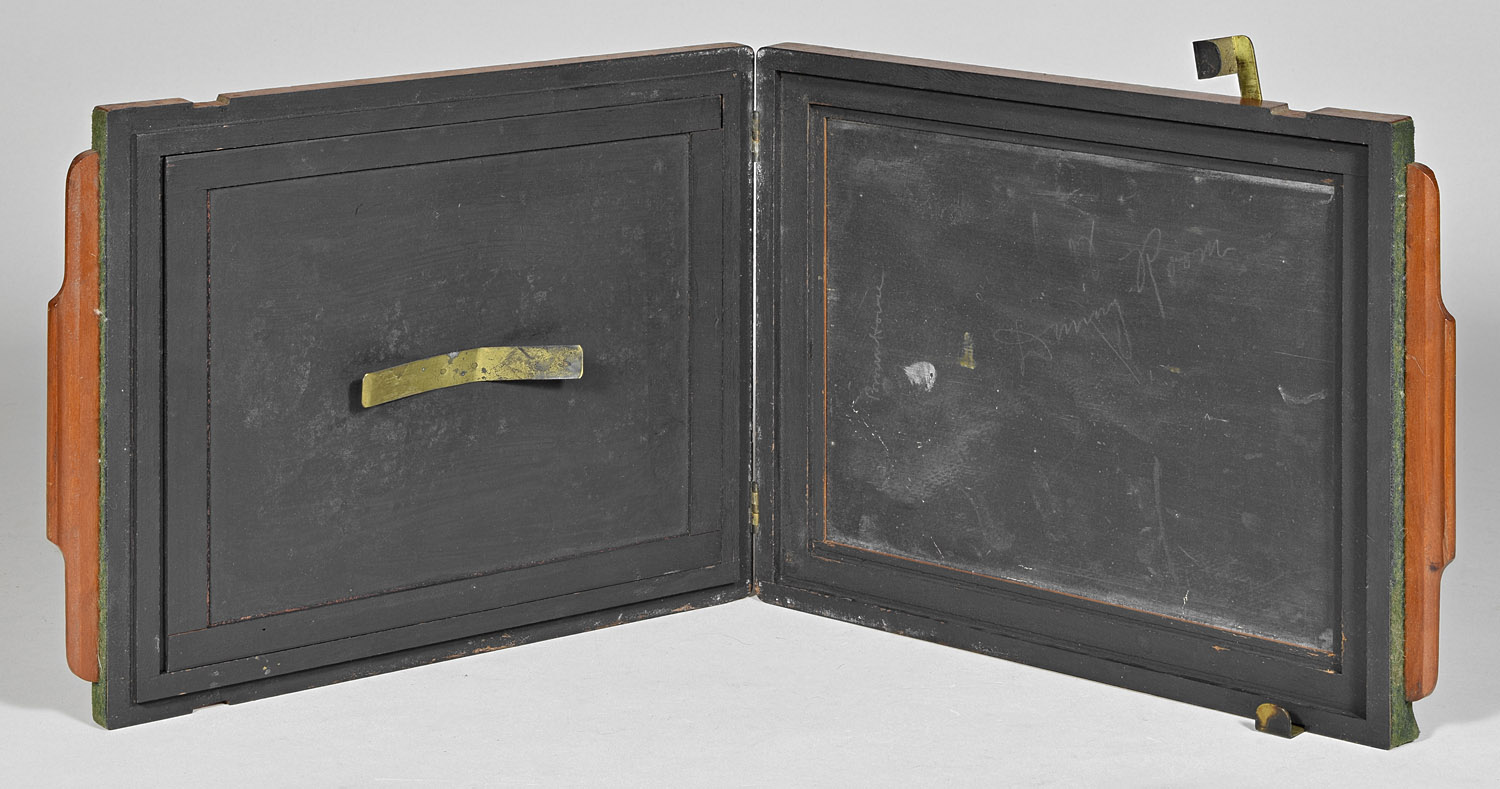
Stamp on the long side of one face of the
plate holder: "Amer. Optical Co. / Scovill Mfg. Co.
NY"

This camera has been used hard and had
problems. How it can have so much damage and still retain its
original, wavy ground glass is a wonder.
Shown below are two parts that have been repaired. The corner on
the left has a poorly done reinforcement. On the right, the top of
the rear standard has been cracked and crudely glued.
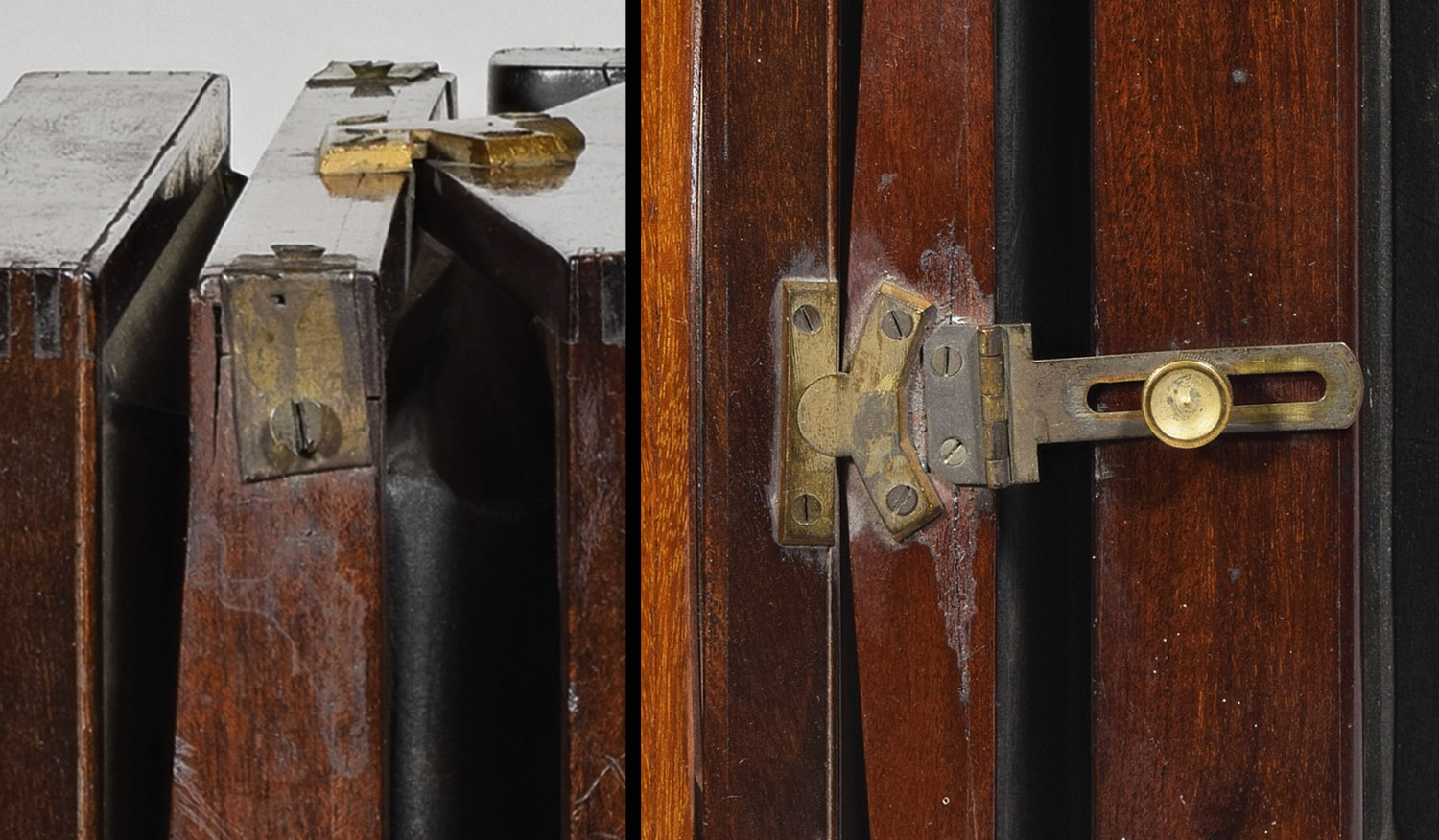
Another reinforcement at a corner of the
rear standard.
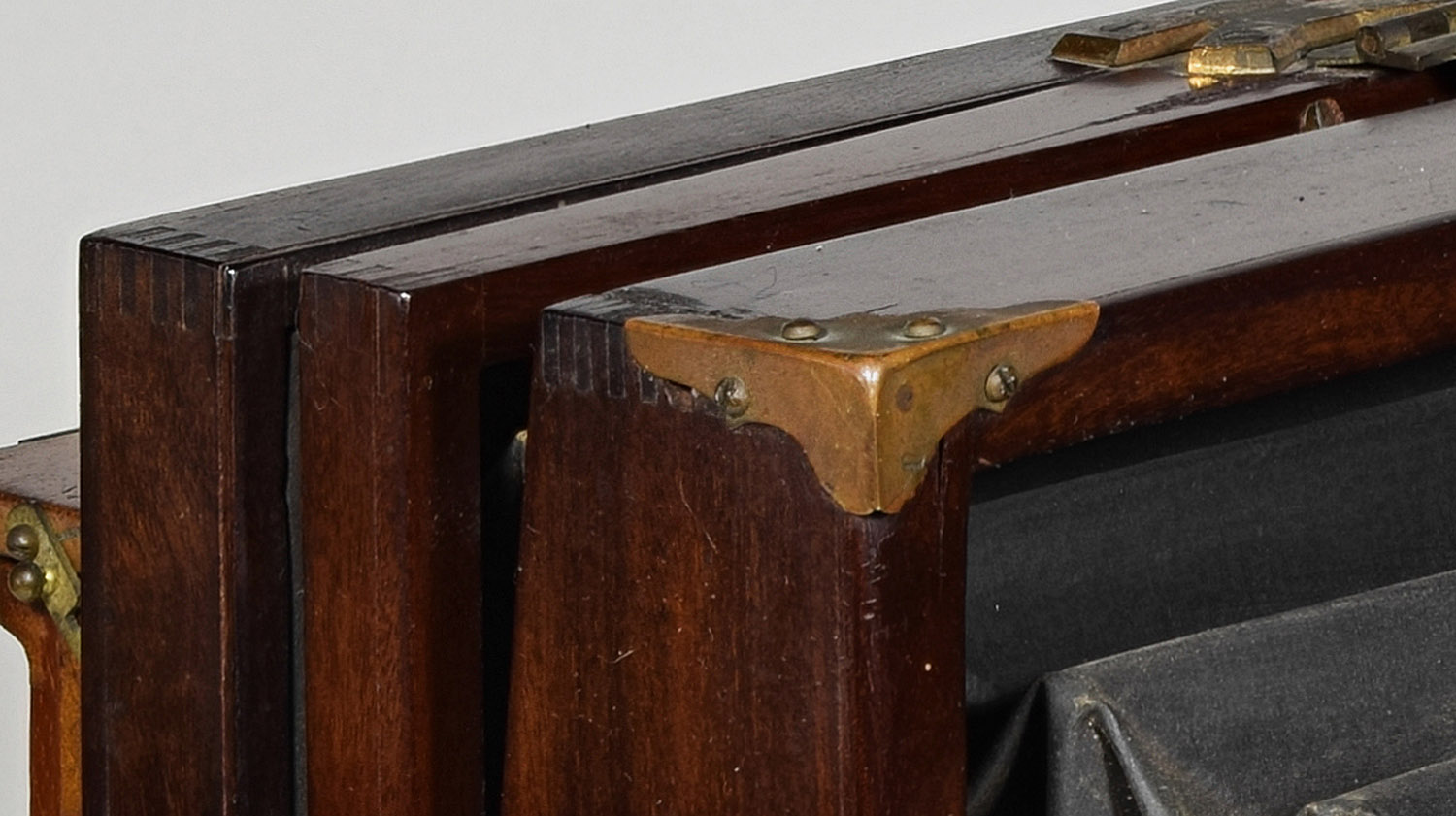
When the camera was shipped to me, the
front standard completely broke at the bottom. Fortunately,
mahogany is rather brittle, and may be put back together fairly well.
Below shows the repair made with hide glue (reversible if desired, and
also the glue originally used for camera manufacture). The cracks
can still be seen at this magnification, but barely.
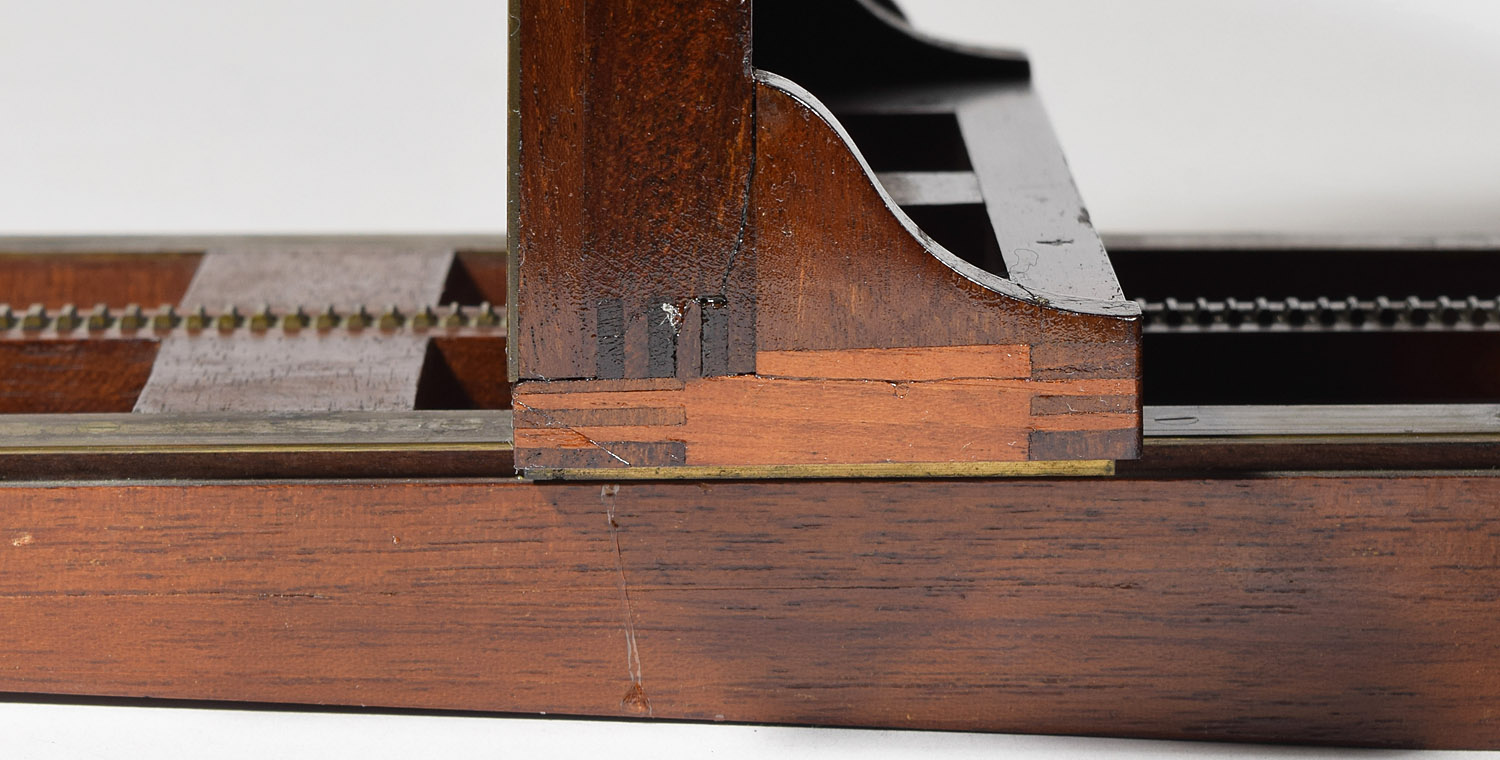
Manufacturer:
American Optical Co. New York, NY factory Back focus and front
focus revolving back cameras were advertised under the same name, i.e.,
Flammang's Revolving Back Camera,
and shared one price list. I always have trouble remembering the
name, because, strictly speaking, the name should be: i.e.,
Flammang's Rotating Back Camera,
since revolution involves an external axis, whereas rotation
involves an internal axis, as in: the earth revolves around the sun in
one year, whereas the earth rotates in 24 hours.
American Optical's
"revolving" back cameras were advertised as being able to use either SGC
(Scovill's Glass Corners) plate-holders (for
wet plates) or Daisy plate-holders (for dry plates). Each camera,
being one of the higher priced models, came in an expensive, but
light-weight canvas "bag", which is probably the
term they used for the canvas-covered cardboard case of the era, or, it could have
come as stated: - in a bag. Either way, the models rarely come in
any type of container, which attests to the frailty of canvas containers
of either type. The revolving back
of the camera usually has a stamp that reads: "Flammang's / Pat. Aug. 21, '83
/ No. 283,589", not to be
confused with a stamp on one or both sides of the camera platform that
reads:: "Flammang's / Pat. Oct. 20, 1885 / (#328,664)", which refers to Flammang's
other major patent, the rod and cylinder device for making a folding bed
rigid. The camera models and variations below contain both
Flammang patent features and commonly are appropriately stamped.
Most of the other American Optical and Scovill cameras of the time had
the rod & piston device and have been erroneously sold
as "Flammang's Patent" cameras merely because they were stamped with its patent date. By late 1896, the
revolving back cameras were consigned to the "Bargain Page" of the American
Annual of Photography and Photographic Times Almanac for 1897 (page
lxi), which probably indicates an attempt to get rid of discontinued
stock. There are a number of
variations listed on this web site. The back and front
focus made cameras must obviously be separated here, as well as the
following variations:
Flammang's Revolving-Back Camera Back Focus
Variation 1.0:
back focus revolving back camera having 1) push-pull focus with a lever in the rear to secure it,
2) forward-back swing hinged at the bottom of the rear standard (as
shown in most engravings) and 3) lacquer-coated brass hardware.
Flammang's Revolving-Back Camera Back Focus
Variation 2.0:
back focus revolving back camera having 1) push-pull focus with a lever
in the rear to secure it, 2) forward-back swing hinged in the middle of
the rear standard, and 3) lacquer-coated brass hardware.
Flammang's Revolving-Back Camera Back Focus
Variation 2.1:
same as Variation 2
(push-pull focus, swing hinged in the middle), except having a device at
the rear standard that, when pushed, allows horizontal swing. The
example is also later than the Variation
2 examples, in that it was made when American Optical was
owned by The Scovill & Adams Co. (after 1889) Flammang's
Revolving Back Camera Back Focus Variation 2.2:
same as Variation 2
(push-pull focus, swing hinged in the middle), except having
nickel-plated hardware.
Flammang's Revolving-Back Camera Back Focus
Variation 3.0:
back focus revolving back camera having 1) rack and pinion focus, 2)
forward-back swing hinged in the middle, and 3) lacquer-coated brass
hardware.
There is also a page featuring a
Counterfeit Revolving Back Camera Back
Focus Variation 3, a camera which superficially looks
like Variation 2, but, in
detail, can be seen to have not been made by the American Optical Co.
Flammang's Revolving-Back Camera Front Focus
Variation 0.9:
front focus revolving back camera having a square-shaped lens board not
suitable for stereo photography. It has a thumbscrew at the lower
rear used to make the folding platform and fixed platform rigid.
This is assumed to have been made before Oct. 20, 1885, the date of the
Flammang patent rod and pocket device.
Flammang's Revolving-Back Camera Front Focus
Variation 1.0:
front focus revolving back camera having a square-shaped lens board not
suitable for stereo photography. This and following variations
have the Flammang patent rod and pocket devices (one each side, usually)
to make the platform rigid. It also has a brass device to prevent
the ground glass or inserted plate holder from moving or falling out.
Flammang's Revolving-Back Camera Back Focus
Variation 2.0:
front focus revolving back camera having a wide, rectangular lens board
suitable for stereo photography. This option was not shown in
advertisements or even mentioned in catalogs.
References:
Back to American Optical
Co. / Scovill Mfg. Co. (alphabetical)
Date Introduced: - ; Years Manufactured:
c.1884-1896
Construction: front focus
via rack and pinion (single gear track on top of middle base rail);
single or double swing; reversing by revolving
back (the Flammang patent); three-piece lens board
Materials: mahogany body; mahogany base;
black fabric bellows; brass hardware; French polish
finish
Sizes Offered: 4x5; 4¼x5½; 5x7; 5x8;
6½x8½; 8x10
Notes:
Descriptive Catalogue and Price List of the Photographic Apparatus
Manufactured by the American Optical Co., Scovill Mfg. Co.,
proprietors and managers (New York, NY), Sept. 1884, pp.54-55
How to Make Photographs and Descriptive Price List,
Scovill Mfg. Co. (New York, NY), distributed by
Andrew J. Smith (Providence, RI),
1886, p. 38
Scovill's Photo. Series No. 12,
Photographic Chemistry, Scovill Mfg. Co.
(New York, NY), 1886, p. a23
Scovill's Photo. Series No. 20, Dry
Plate Making for Amateurs, Scovill Mfg. Co. (New
York, NY), 1886, p. a15
How to Make Pictures, 4th edition, Henry Clay Price, Scovill Mfg.
Co., publishers (New York, NY), dated 1887, copyright 1886, p.a13
The American Annual of Photography and Photographic Times Almanac for
1888, C.W. Canfield, ed.; Scovill Mfg. Co. (New York, NY), copyright
1887, ads p. 57
Scovill's Photographic Series No. 26,
The Photographic Instructor, Prof.
Charles Ehrmann, Scovill Mfg. Co., 1888,
ads p. xvi
Catalog P, Photographic Material, J. W.
Queen & Co. (Philadelphia, PA), 1886, p. 74 (As
Revolving Back Camera, Front Focus)
Photographic Lenses and How to Select Them, James W. Queen & Co.
(Philadelphia, PA), 1887, p. 27
How to Make Photographs and Descriptive Price List,
Scovill Mfg. Co. (New York, NY), distributed by
C.H. Codman & Co. (Boston, MA), April 1887, p.
37
How to Make Photographs and Descriptive Price List,
Scovill Mfg. Co. (New York, NY),
undated but about January 1888, pp. 39-40
How to Make Photographs and Descriptive Price List,
Scovill Mfg. Co. (New York, NY), distributed by C.H.
Codman & Co. (Boston, MA), September
1888, p. 29
How to Make Photographs and Descriptive Price List,
Scovill Mfg. Co. (New York, NY), distributed by Buchanan, Bromley
& Co. (Philadelphia, PA) Catalog, 1888
How to Make Photographs and Descriptive Price List,
The Scovill & Adams Co.
(New York, NY), January 1889, p. 28
How to Make Photographs and Descriptive Price List,
The Scovill & Adams Co. (New York, NY), distributed by Buchanan,
Bromley & Co. (Philadelphia, PA) Catalog, 1889
American Annual of Photography and Photographic Times Almanac for
1890, The Scovill & Adams Co. (New York, NY),
ads p. 100
How to Make Photographs and Descriptive Price List,
The Scovill & Adams
Co. (New York, NY), distributed by Oscar Foss (San Francisco, CA), June
1890, pp. 29-30
Photographic Material,
Catalogue O & P, James W. Queen & Co. (Philadelphia,
PA), 1891, p. 60 (as Revolving Back Camera Front
Focusing)
How to Make Photographs and Descriptive Price List,
The Scovill & Adams
Co. (New York, NY), January
1891, p. 30
How to Make Photographs and Descriptive Price List,
The Scovill & Adams
Co. (New York, NY), distributed by Sargent & Co. (Cleveland, OH), April
1891, p. 21
How to Make Photographs and Descriptive Price List,
The Scovill & Adams
Co. (New York, NY), distributed by Horgan, Robey & Co. (Boston, MA),
June 1891, p. 21
American Annual of Photography and Photographic Times Almanac for
1892, The Scovill &
Adams Co. (New York, NY), 1891, p. 94
How to Make Photographs and Descriptive Price List,
The Scovill & Adams Co.
(New York, NY), January 1892, p.
21 (as Revolving Back Camera Front Focus Pattern)
How to Make Photographs and Descriptive Price List,
The Scovill & Adams
Co. (New York, NY), abt. June 1892, p. 20 (as Revolving Back
Camera Front Focus Pattern)
American Annual of Photography and Photographic Times Almanac for
1893, The Scovill & Adams Co. (New York, NY),
1892, p. 90
The American Annual of Photography and
Photographic Times Almanac for 1894, The
Scovill & Adams Co. (New York, NY), 1893, p. 95
How to Make Photographs and a Descriptive
Catalogue of Photographic Materials Illustrated,
Scovill & Adams Co. (New York, NY),
1896, p. 35
Wilson's Cyclopaedic Photography, Edward L. Wilson (New York,
NY), copyright 1894, p. 478
American Annual of Photography and Photographic Times Almanac for
1897, The Scovill & Adams Co., ads p.
cii (engraving in an ad for
Obrig Camera Co. (New York, NY); also on the "Bargain Page", page 61
The International Annual of Anthony's
Photographic Bulletin, Vol. X, 1897,
E. & H.T. Anthony & Co. (New York, NY), 1897,
p. 83 (engraving in an ad for Obrig Camera Co. (New
York, NY)
American Annual of Photography and Photographic Times
Almanac for 1898,
The Scovill & Adams Co. (New York, NY), 1897, ads
p. 115 (Bargain Page)
